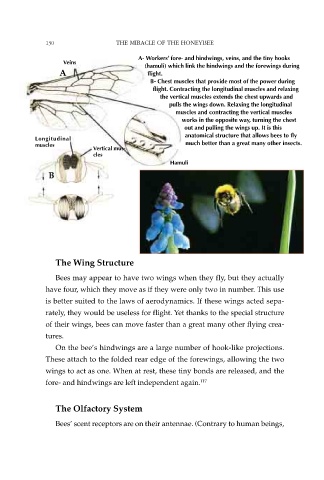Page 132 - The Miracle of the Honeybee
P. 132
130 THE MIRACLE OF THE HONEYBEE
A- Workers’ fore- and hindwings, veins, and the tiny hooks
Veins
(hamuli) which link the hindwings and the forewings during
A flight.
B- Chest muscles that provide most of the power during
flight. Contracting the longitudinal muscles and relaxing
the vertical muscles extends the chest upwards and
pulls the wings down. Relaxing the longitudinal
muscles and contracting the vertical muscles
works in the opposite way, turning the chest
out and pulling the wings up. It is this
anatomical structure that allows bees to fly
Longitudinal
muscles much better than a great many other insects.
Vertical mus-
cles
Hamuli
B
The Wing Structure
Bees may appear to have two wings when they fly, but they actually
have four, which they move as if they were only two in number. This use
is better suited to the laws of aerodynamics. If these wings acted sepa-
rately, they would be useless for flight. Yet thanks to the special structure
of their wings, bees can move faster than a great many other flying crea-
tures.
On the bee’s hindwings are a large number of hook-like projections.
These attach to the folded rear edge of the forewings, allowing the two
wings to act as one. When at rest, these tiny bonds are released, and the
fore- and hindwings are left independent again. 117
The Olfactory System
Bees’ scent receptors are on their antennae. (Contrary to human beings,

